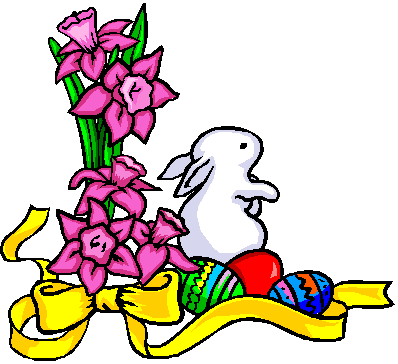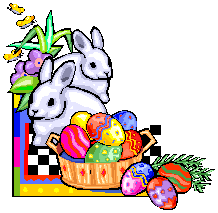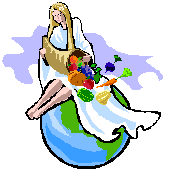
 Celtic/Welsh
Tradition
Celtic/Welsh
Tradition
If you have read the Mabinogion myth, this is where the God of Light conquers his darker twin. The Goddess who has become the Maiden again since Imbolc, welcomes her Child and soon to be spouse. She watches him grow proudly. Pagans of old would light fires at dawn for protection of crops to come, renewed life, and cures to aliments they battled with over the hard Winter months.
![]()
Christian Traditions
The Roman Catholic Church adopted two holidays from the pagan celebrations. The
first being the Annunciation of the Blessed Virgin Mary, when the angel Gabriel
told Mary that she was to become the Mother of God's Son (fixed date of March
25th). This day was chosen because it needed to be the exact nine months to
December 25th, when the Son of God was said to be born. Even though she was
birthing the Son of God, she's still human. I suppose an irregular gestation
period would have been seen as Satanic. For this reason many Christians seem to
think that any mention of "Lady Day" refers to this Christian Holiday, when it
is referring to Ostara if coming from a Pagan mouth. If you take a closer look,
this mythology was used long before Christian times. The Goddess returning to
her Maiden, or Virgin (in this case meaning the original 'unmarried') aspect,
was already established in Celtic lore. This is the time that the Young God and
Maiden begin to create life again.
The second holiday that gets inappropriately combined with Ostara is Easter. Not
so surprisingly either. Easter is also a celebration of life over death as Jesus
rises again; just like the God of Light rises again to defeat the God of
Darkness. Easter's name is derived from the Teutonic Goddess Eostre, (which
incidentally is where we also get the name "estrogen" from), who's symbols were
the Egg and the Rabbit. I know lights are going off, so yes... exactly where the
Easter Bunny and Easter Eggs came from. Rabbits are a symbol of fertility (as in
"doing it like bunnies" in reference to sexual habits) and Eggs are a symbol of
creation. As stated before, Her day is Ostara, the night of the Vernal Full
Moon. The Church doesn't do Full Moons, but Easter is on the first Sunday after
the Full Moon after the Vernal Equinox each year, and that's why it doesn't have
a set date on the calendar. Furthermore, if Easter Sunday by chance did happen
to be on the Vernal Full Moon, the Church was very adamant in being sure it was
moved to the following Sunday so there would be no suspected association with
"wicked" Pagan holidays.
Another not so striking similarity between general pagan mythology and Christian
mythology - Jesus, after being Crucified on Good Friday, "descends into Hell"
(also called the "Harrowing of Hell"). After the third day he rises again and
proceeds to Heaven. Many of the older myths around the world speak of the
Goddess descending into the Underworld for three days, continuing the trinity
trend. Furthermore, it is said to coincide with the Vernal New Moon, which is
not visible for three days, both the day before, the day of, and the day after.
These myths had existed for many thousands of years before the coming of
Christianity.
Wiccan Myth
The Goddess transfers Her fertility to the Earth and takes on the Maiden aspect. The God grows to maturity and will soon become the Goddess' lover at Beltane. For most Wiccans it is a celebration of fertility and growing Light.
Symbols of Ostara
- Other Names:
Eostre's Day, Spring Equinox, Vernal Equinox, Alban Eiber, Lady Day, and
Easter.
- Colors: Silver, Green, Lavender, Grass
Green, Robin's
Egg Blue, Lemon
Yellow and Pale
Pink.
- Symbols: Eggs,
New Moon, Butterflies, Cocoons, Baskets and the Equilateral Cross.
- Ritual Meaning: Balance,
New Life/Rebirth, Goddess and God in Youth, Light overtaking Darkness,
and the God's Coming of Age.
- Key Actions: Open
and Begin
- Ritual Oils: Lotus,
Magnolia and Ginger
- Stones: Amethyst,
Aquamarine, Bloodstone, & Red Jasper
- Plants: Roses,
Strawberries, Seasonal Fruit Plants, Violets, Honeysuckle, Easter Lily,
Dogwood, Daffodil, Iris, Irish Moss, Jonquil, Apple Trees (blossoms
specifically), and Alder.
- Activities: Dyeing
Eggs, and Looking for Spring Growth.
- Taboos: none
known
- Animals: Rabbits,
Cougar, Sea Crow, Sea Eagle, Hedgehog, and Boar.
- Mythical
Creatures: Merfolk and
any other Air or Water beings
- Deities: Eostre
(who can also be connected with Ishtar and Astarte), the Green Goddess,
Aphrodite, Hera, Artemis, Athena, Isis, Astarte, Cybele, Hecate, Luna,
Minerva, the Morrigan, the Muses, Persephone, Adonis, Dagda, Pan, Aengus
Óg, Aries, Eros, and the Horned God
- Foods: Hard
boiled eggs, Honey Cakes, First Fruits of the Season, Nuts, Seeds, Leafy
Veggies, and of course Chocolate!
- Drinks: Lemonade, Egg-Nog, Anything that you can whip up from the seasonal fruits and berries.
![]()
Easter Bunny
 Ostara
comes from a Latin name for the Spring Goddess Eostre, for whom Easter was
named. In fact, the story of the Easter Bunny which delights children so much in
America comes from the legend of a humble little rabbit's dealings with the
Goddess Eostre. As the legend goes, a lowly little rabbit wanted so much to
please his Goddess that he laid sacred eggs in her honor and decorated them in
beautiful rainbow colors. When the rabbit presented Eostre with his gift, she
was so pleased that she desired for all humans to share in her joy and asked the
little rabbit to go throughout the world distributing the little gifts.
Ostara
comes from a Latin name for the Spring Goddess Eostre, for whom Easter was
named. In fact, the story of the Easter Bunny which delights children so much in
America comes from the legend of a humble little rabbit's dealings with the
Goddess Eostre. As the legend goes, a lowly little rabbit wanted so much to
please his Goddess that he laid sacred eggs in her honor and decorated them in
beautiful rainbow colors. When the rabbit presented Eostre with his gift, she
was so pleased that she desired for all humans to share in her joy and asked the
little rabbit to go throughout the world distributing the little gifts.
![]()
Eggs
 This
is the time of year when we decorate eggs, and the bunny hides them. The basket
full of decorated eggs symbolizes the womb full of fertility almost ready to
burst forth onto the Earth. During Ostara, eggs are decorated and used as altar
decorations to honor the Goddess and the God, as well as carried as magical
talismans for fertility. As sacred objects of life and fertility, eggs are also
given as cherished gifts.
This
is the time of year when we decorate eggs, and the bunny hides them. The basket
full of decorated eggs symbolizes the womb full of fertility almost ready to
burst forth onto the Earth. During Ostara, eggs are decorated and used as altar
decorations to honor the Goddess and the God, as well as carried as magical
talismans for fertility. As sacred objects of life and fertility, eggs are also
given as cherished gifts.
The Great Rite, symbolic of the sexual union between Goddess and God and of the
physical and spiritual union between all men and women, began to be enacted on
the day of Ostara. The positive effects of this rite, a form of sympathetic
magic, helped to bring fertility to the people, the land, and their animals.
Day and night are equal as Spring begins to enliven the environment with new
growth and more new born animals. The enigmatic egg is a powerful symbol of the
emergence of life out of apparent death or absence of life.
![]()
Lady Day
 In
Wales, Ostara was known as Lady Day and signified the official return of the
Goddess from her long winter hibernation. Many of the myths associated with
Ostara concern trips by deities into the mysterious underworld, and their
struggle and eventual return to the land of the living.
In
Wales, Ostara was known as Lady Day and signified the official return of the
Goddess from her long winter hibernation. Many of the myths associated with
Ostara concern trips by deities into the mysterious underworld, and their
struggle and eventual return to the land of the living.
Many people feel "reborn" after the long nights and coldness of winter. The
Germanic Goddess Ostara or Eostre (Goddess of the Dawn), after whom Easter is
named, is the tutelary deity of this holiday. It is she, as herald of the sun,
who announces the triumphal return of life to the earth.
Witches in the Greek tradition celebrate the return from Hades of Demeter's
daughter Persephone; Witches in the Celtic tradition see in the blossoms the
passing of Olwen, in whose footprints flowers bloom.
Lady Day may also refer to other goddesses (such as Venus and Aphrodite), many
of whom have festivals celebrated at this time.
Persephone
In fall, Persephone is stolen away by Hades, Lord of the Underworld. Demeter,
driven almost to frenzy by the abduction of her precious daughter (a younger
form of Demeter herself), blasts the earth and refuses to let anything grow
until her daughter is restored to her.
Unfortunately, it isn't so simple. Persephone is also a death goddess, and she
found in the underworld that her husband, Hades, was not entirely offensive to
her. Despite knowing better she has eaten 6 pomegranate seeds, a potent
blood-red symbol of female power, so no one can compel her to return to her
mother and the pleasures of girlhood.
She still loves her mother, however, and eventually a deal is worked out.
Persephone will return to the above world for half of the year, depending on the
different variations of the legend. In spring, she re-emerges and Demeter's
delight is so great that she allows the earth to burst forth into bloom. Hades,
his time of power being the fall and winter, retreats for a time until the next
Equinox, in fall, when he will again abduct Persephone and continue the unending
cycle
![]()